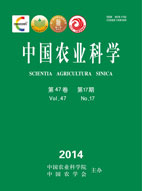-
Analysis of Maize Grain Filling Rate in Different Heterotic Groups
- ZHANG Dong-mei, LIU Yang, ZHAO Yong-feng, ZHU Li-ying, HUANG Ya-qun, GUO Jin-jie, CHEN Jing-tang
-
Scientia Agricultura Sinica. 2014, 47(17):
3323-3335.
doi:10.3864/j.issn.0578-1752.2014.17.001
-
 Abstract
(
579 )
Abstract
(
579 )
 HTML
(
3 )
HTML
(
3 )
 PDF (635KB)
(
1020
)
PDF (635KB)
(
1020
)
 Save
Save
-
Related Articles |
Metrics
【Objective】The objective of this experiment was to study the characteristics of grain filling rate of different heterotic groups and to select the excellent inbred lines with fast grain filling rate, providing the reference for the selection of high yield maize hybrids.【Method】A total of 173 maize inbred lines were used as experimental materials. The drying method was used to determine grain filling rate of 10, 20, 30, and 40 days after pollination and 6 related correlation characters. The combined analysis of variance for year, lines, sample time, repetition, year×lines, lines×sample time, year×lines×sample time were carried out by SAS software; and the SPSS software was used to perform the correlation analysis on the grain filling rate and its related traits such as the husk moisture content 10, 20, 30, and 40 days after pollination, the number of husks, the cob moisture content 40 days after pollination, the cob length, the cob diameter and the grain moisture content 40 days after pollination. A genome-wide scan was performed on the material by using 210 pairs of SSR markers evenly covering maize genome, and the population structure of these materials was revealed by Structure V2.3.4. Variance analysis of the average grain filling rate for different heterotic groups was also carried out to screen the lines with fast grain filling rate and know which group they belong to. 【Result】 Phenotypic analysis showed that the grain filling rate was very significantly different among different years, inbred lines, sampling times, lines×sampling time and lines×sampling time but repetition and year×lines at 0.01 levels. The correlation analysis showed that the grain filling rate on 10 and 20 days reached a extremely significantly positive correlation at 0.01 levels (0.515); and the 10 days grain filling rate with the 40 days grain filling rate and grain water content achieved significant negative correlation at 0.01 levels (-0.198, -0.228); at 0.05 levels, the 20 days grain filling with the 40 days grain moisture had notable negative correlation; the grain filling rate on 30 and 40 days with the 40 days cob moisture content, cob diameter, the 40 days grain water content, 30 and 40 days husk moisture content had extremely significant correlation at 0.01 levels; the correlation was found between 30 days and 10 days husk water content was significant; and the 40 days grain filling rate had very significant positive correlation with the 20 days husk water content. The population structure analysis showed that these maize inbred lines could be divided into 5 heterotic groups which are P, LRC, Reid, Lancaster and TangSPT groups. The variance analysis among the 5 heterotic groups showed that Lancaster and TangSPT had no significant difference at 0.05 level, the similar situation also emerged among the Reid, P and LRC groups, but Lancaster, TangSPT and Reid, P, LRC groups had significant difference. For multiple comparisons within each group between inbred lines, each group in inbred lines of grain filling rate at 0.05 levels had no significant difference. Thirty-three inbred lines with the filling rate higher than 0.8 g•100 grain-1•d-1 were screened in this study, and there are 13 lines in the Reid group, P, LRC, Lancaster, and TangSPT occupy 9, 6, 3, and 2 inbred lines, respectively. 【Conclusion】The grain filling rate showed significant differences among maize inbred lines, and it has different rhythm among the heterotic groups, P, LRC and Reid groups showed quick-quick-slow changing mode, while Lancaster and TangSPT groups showed quick-slow-slow changing rhythm.









